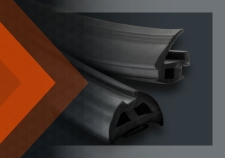
Previously, we have discussed Why Access Control might be the solution you need, as well as the 3 common Access Control Systems and the 7 components that go into a typical Access Control System. In this article, we look closely at one specific product, that comes under the Locking Device category, Electronic Multipoint door locks.
Electronic multipoint door locks are already very popular and continue to increase in popularity every year. They are regularly used in commercial settings, and in communal entrance doors for residential buildings. There is also increasing demand for electronic multipoint door locks as locking devices for private residential entrance doors, especially where disabled users mean conventional keys and levers are problematic.
Many of our customers have expressed an interest in knowing more about these products, how they connect to an access control system, and how they differ in terms of installation to a standard multipoint door locking system.
In this article, we take a quick look at a typical electronic multipoint locking system and offer an overview on how easy it is to fit, and what information is needed when ordering an electronic multipoint lock. We will be looking specifically here at a popular range of electronic multipoint door lock; the Winkhaus AV2 system. It is a high-quality product range, approved for use in fire door sets, and comes in a comprehensive range of variations. It has therefore proved particularly popular with specifiers for use in the communal entrances of buildings with multiple occupants. Chances are you may have come across an AV2 system already so it’s a great place to start for those less familiar with these products.
What is the difference between a ‘normal’ multipoint door lock and an electronic one like the GU Secury or Winkhaus AV2?
Electronic Multipoint Door Locks are just like conventional multipoint door locks aside from 2 main differences, generally speaking. They are measured the same way and have the same considerations in terms of locking points required, backset sizes, faceplate types, etc. So if you are comfortable identifying and specifying a conventional multipoint door lock, you already have all you need to get the right electronic multipoint for your application. They fit into the door in the same way as a normal multipoint and use euro profile cylinders and bolt through furniture.
So what are these differences?
Operation
The first relates to how the multipoint works mechanically, or its operation. Conventional multipoint door locks may be split spindle, or double spindle nightlatch operation, lift lever operation, or less commonly nowadays, key wind operation. Electronic multipoint door locks such as the Winkhaus AV2 however, will usually feature automatic operation.
So what does automatic operation mean? Well unlike lifting the lever, or turning the key to throw the locking points, automatic operation, as the name suggests, relies upon small triggers of various designs to release the locking points which are spring-loaded to throw. Depending on the manufacturer you are using these may be latch bolts, deadlocking bolts, or hook bolts. In the case of the AV2 we are looking at here, they are hook bolts. The triggers themselves are activated when the door is closed and the lock meets the keep. In some systems, this may mean a small magnet senses the lock, in others, it may be an electrical sensor of some sort, but with the types we currently stock including the AV2, it involves simple mechanical triggers that are pushed in by the keep and throw the locking points.
Another feature of automatic operation is that the spindle follower is a single solid follower and not split, meaning there is no night latch function. This means the spindle will at all times retract the locking points. For this reason, it changes the type of furniture normally fitted in conjunction with these types of locks. Most often there will be no external lever or a fixed pad handle that doesn’t turn a spindle. This ensures that entry from the outside can only be achieved using 1 of two methods, either via the access control system or via the conventional euro profile lock cylinder if fitted, which will also always retract the locking points.
So what is the other main difference?
Addition of a Motor
The presence of an electronic motor is the other main difference between an electronic multipoint lock and a conventional one. The motor is sometimes contained within the main central gearbox of the mechanism, on most examples, however, including the Winkhaus AV2 and the GU Secury A-Opener stocked at Duffells, the motor is a totally separate unit that attaches to the faceplate of the lock strip. It usually sits somewhere either just above or just below the main central gearbox.
So what does the motor do?....
The motor essentially does the same job as the lever handle would do. It moves a cam that is attached to the sliding rail on the back of the multipoint lock, sliding it up and down in the same way the lever handle normally would. When the motor moves the rail, it retracts the latch bolt and top and bottom locking points, such as the hooks or deadlatches.
So, locking is achieved automatically by spring-loaded triggers that throw the locking points, and unlocking is achieved either by the lever handle retracting the locking points (from the inside) or electronically by the motor doing its job instead.
The basic installation of an electronic multipoint lock really is no more complicated than the basic installation of a conventional mechanical version then. The only real difference is the furniture you chose to ensure there is no active lever on the outside, and the fact there would need to be an extra aperture routed into the door to accept the gearbox. Other than that from a practical perspective there is very little difference.
At this point you are thinking yes, getting it into the door seems straightforward, but wiring it up to work with the access control system probably isn't… Well, in fact, the wiring is very basic.
All electronic multipoint locks we sell have their own dedicated connecting cable that fits directly to the motor of the locking system. With the Winkhaus Av2, this is a 6-meter long grey cable available separately, and with the GU systems, it is a black cable that comes supplied with the motor. Both of these cables contain several cores but in the majority of access control applications there are only 3 connections that need to be made:
- One is a permanent live connection to a suitable power supply. Effectively connecting one of the conductors directly to the positive terminal of the systems P.S.U.
- One is a Trigger signal sent by the access control device when it is time to open the door. This connection is usually made using the lock relay of the access control systems door controller (or user interface such as keypad if a self-contained system)
- The last one is a negative connection directly to the negative terminal of the system's PSU.
In the case of the Winkhaus AV2 system, the white conductor would be for the permanent live connection, the green would be for the trigger signal and the brown conductor is the negative back to the power supply.
Below is an example from the Winkhaus installation guide that shows an example wiring layout for a basic access control system:

These 3 conductors are all that is needed to connect the electronic multipoint locking system to your access control application. So it really is barely more complicated than connecting a standard electronic latch release or a magnetic lock, what’s more, our Duffells Technical Team is available to help via email, phone or WhatsApp should you encounter any issues on site.
For this reason, we believe these locking devices represent a great opportunity for anybody who is comfortable working with conventional multipoint locking systems, to expand easily into offering access control compatible solutions.





